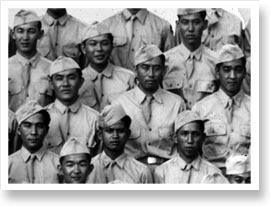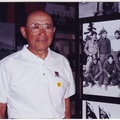The nisei veterans have been called everything from heroes to cultural icons to saviors of the Japanese American community. Stories of the rescue of the "Lost Battalion" and the breaking of the Gothic Line are so harrowing and so poignant that it is easy to see why they hold an iconic status in our community. Yet, if we go back to 1943 – in the weeks following an announcement by the U.S. Government that opened the military to Japanese Americans – we see a group of individuals forced to make very human decisions under the most difficult of circumstances. Why these men decided to volunteer for the army, and the issues surrounding this decision, is the subject of this month's feature article.
Prior to the bombing of Pearl Harbor on December 7, 1941, approximately 5,000 Japanese Americans were serving in the military. When war broke out, many of these nisei, U.S. born children of Japanese immigrants (issei), were discharged or placed in non-combat positions. Meanwhile, those nisei who rushed to enlist were rejected by local induction boards. An order by the War Department on March 30, 1942, officially discontinued the induction of Japanese Americans on the West Coast. A few months later, the government announced that no persons of Japanese ancestry, regardless of citizenship, would be eligible for military service. This policy would remain intact for almost one year.
Spady Koyama, a nisei from Spokane, Washington, was one of the few Japanese Americans able to enlist in the chaotic months following Pearl Harbor. At the urging of his issei mother, Spady prevailed against numerous barriers, and was inducted into the U.S. Army in January 1942. Spady credits his mother for sparking his decision to enlist when she told him, "this is your country, no matter who says what."
[Spady Koyama] "So on 5th of January, I packed up, said goodbye to everybody and walked to the selective service office so many blocks away and say that I'm ready to go. Well he told me, "Well you better go, go home and think things over first. We're at war with Japan, you know." I said, "I know that. That's why the only thing I'm here for." And they kept telling me to go home. And the longer I stayed there, the more, well I wasn't exactly angry, but I was disturbed more than anger. So I finally push the piece of paper across the top of the desk and I said, "How about give me your name. Print, print your name on this piece of paper and give me the names of the rest of you fellas here in this selective service office." And he said, "What do you want our names for?" And I said, "If they tell me in Fort Lewis that I don't qualify, then I will come home, but you fellas here in Spokane don't even want to send me over there. Human interest story there, I'm going give it, give it to one of my buddies (who works for a) newspaper. I want your names." So he went back and told the others about it and he came back and said, "Well don't blame us if something happens to ya." I said, "Oh, no. You'll be safe. Just send me out of here." And that's how I got, got to. I think not Ft. Lewis, but Camp Murray, I believe. And there I raised my right hand and earned twenty-one bucks as a buck private on 8th of January. Month and a day after Pearl Harbor."
Mas Watanabe was one of the 1,200 nisei who made the difficult decision to volunteer from behind barbed wire. Like many of his peers, Mas was aware of the irony of the government's call for an all-nisei combat team. Despite feelings of anger and alienation over the government's treatment of Japanese Americans, Mas volunteered for the army and spent the remainder of the war fighting with the 442nd in Europe.
[Mas Watanabe] "Initially, I was wondering, "What the hell is this?" I think those of us who did react to it positively, I think we did the right thing. And to this day -- well, regardless of what people think -- I think we did the right thing in volunteering after being kicked in the butt. "
[Tom Ikeda] "Why do you think so? What makes you think that that was the right thing to do? "
[Mas Watanabe] "Because, gee, if you're going to live here, you've got to be a part of society. You've got to do what is expected of you. And I had no problem volunteering. I don't know which was worse: being locked up in camp or going off to war. In my mind, barbed wires aren't very, very inviting. "
Tosh Yasutake also volunteered for the army while incarcerated in Minidoka. Tosh's father, Jack, had been picked up by the FBI immediately following Pearl Harbor and was detained in Lordsburg internment camp when Tosh heard about the call for volunteers. With his father's future uncertain, Tosh made the decision he felt was the best for his family, despite personal reservations about fighting in a segregated unit.
[Tosh Yasutake] "I thought that if they were going to volunteer or even be drafted in the army, they ought to just assimilate us among the hakujin troops and not have a segregated unit. And so many of the friends and working in the hospital had already volunteered, but I didn't until the very last day because of that. I was holding out, hoping that they'd say that they would assimilate us to, if we wanted to we could go to some other units. But they didn't say that. And finally in desperation, the last day I decided that maybe if I did volunteer that it might help my dad get released a little earlier. So I did volunteer. "
The War Department's call for volunteers on the mainland elicited fewer responses than expected. In contrast, nearly 10,000 Japanese Americans volunteered for the army in Hawaii, where mass incarceration had not occurred. Senator Daniel Inouye, a Hawaiian of Japanese ancestry, enlisted immediately following the government's activation of the 442nd Regimental Combat Team. When Senator Inouye arrived on the mainland for basic training, he was shocked to discover the existence of incarceration camps. As more nisei soldiers from Hawaii learned of the camps, and in some cases, saw them firsthand, it forced them to reflect on their own decisions to volunteer.
[Senator Daniel Inouye] "Then I remember when we turned the corner, the bend of the road, and the valley came into view, and what we saw was row after row of barracks. Now, we thought this was a military camp and that we going to pass that to go someplace else. But no, we came up to this camp and stopped. High barbed wire fences and there are machine gun towers all around the camp with men there with machine guns. And greeting us at the camp, at the gate, were men in uniform with rifles and bayonets. We are in uniform and I thought, "What in the world is happening?" Then you look into the camp and there they were. And we tried our best to be happy and sociable, but it's not easy realizing what was happening there. And when we left, the atmosphere was totally different. Because when we arrived, we were all singing and playing ukuleles and having a great time, and when we left, it was absolute silence all the way to Mississippi. No one talked. And I can imagine what was going through their minds, and I think almost all of us must have asked ourselves -- would we have volunteered? "
In total, more than 33,000 Japanese American men and women served in the military during World War II. As Veterans Day approaches, it is important to celebrate them not only as legendary war heroes, but complex individuals who persevered during a dark time.
*The transcripts (italics) correspond to video clips that you can view from the Densho Archives.
** The article was provided by Densho , Discover Nikkei Participating Organization, in recognition of Veterans Day.
© 2006 Denshō







